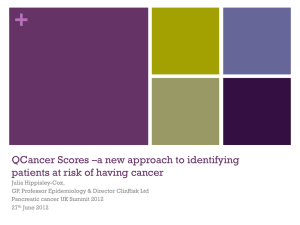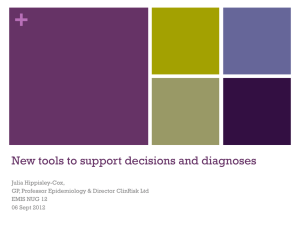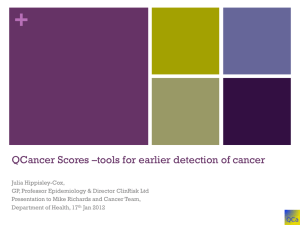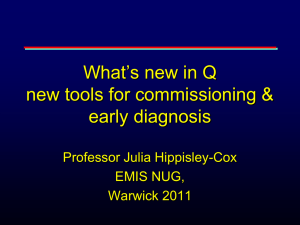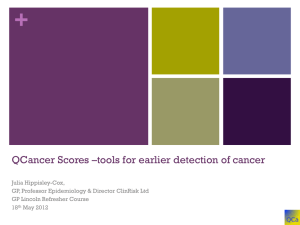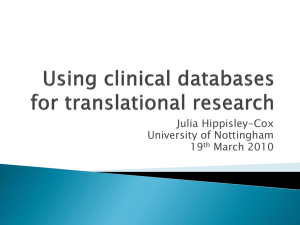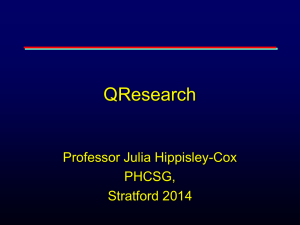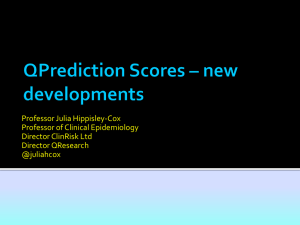Powerpoint - Priimary Health Care 2012
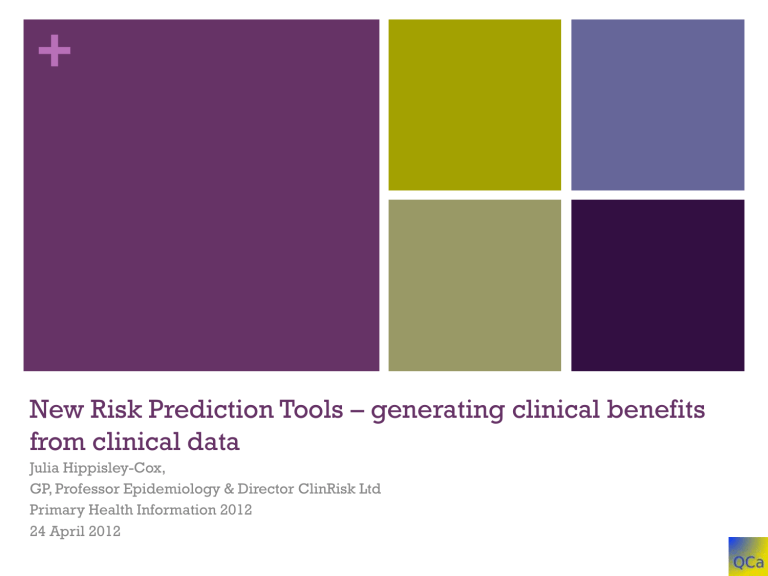
+
New Risk Prediction Tools – generating clinical benefits from clinical data
Julia Hippisley-Cox,
GP, Professor Epidemiology & Director ClinRisk Ltd
Primary Health Information 2012
24 April 2012
+
Acknowledgements
Co-author Dr Carol Coupland
QResearch database
University of Nottingham
ClinRisk (software)
EMIS & contributing practices & EMIS User Group
BJGP and BMJ for publishing the work
Oxford University (independent validation)
+
About me
Inner city GP
Clinical epidemiologist University Nottingham
Director QResearch (NFP partnership UoN and EMIS)
Director ClinRisk Ltd (Medical research & software)
Member Ethics & Confidentility Committee NIGB
+
QResearch Database www.qresearch.org
Over 700 general practices across the UK, 14 million patients
Joint not for profit venture University of Nottingham and EMIS
(supplier > 55% GP practices)
Validated database – used to develop many risk tools
Data linkage – deaths, deprivation, cancer, HES
Available for peer reviewed academic research where outputs made publically available
Practices not paid for contribution but get integrated
QFeedback tool and utilities eg QRISK, QDiabetes.
+
QFeedback – integrated into EMIS
+
Clinical Research Cycle
Clinical practice & benefit
Integration clinical system
Clinical questions
Research + innovation
+
QScores – new family of Risk Prediction tools
Individual assessment
Who is most at risk of preventable disease?
Who is likely to benefit from interventions?
What is the balance of risks and benefits for my patient?
Enable informed consent and shared decisions
Population level
Risk stratification
Identification of rank ordered list of patients for recall or reassurance
GP systems integration
Allow updates tool over time, audit of impact on services and outcomes
+
Current published & validated
QScores scores
QRISK
QDiabetes
QKidney outcome Web link
CVD www.qrisk.org
Type 2 diabetes www.qdiabetes.org
Moderate/severe renal failure www.qkidney.org
QThrombosis VTE
QFracture Osteoporotic fracture
Qintervention Risks benefits interventions to lower CVD and diabetes risk
QCancer Detection common cancers www.qthrombosis.org
www.qfracture.org
www.qintervention.org
www.qcancer.org
+
Today we will cover two types of tools
Prognostic tool – QFracture
Diagnostic tool - QCancer
+
QFracture: Background
Osteoporosis major cause preventable morbidity & mortality.
2 million women affected in E&W
180,000 osteoporosis fractures each year
30% women over 50 years will get vertebral fracture
20% hip fracture patients die within 6/12
50% hip fracture patients lose the ability to live independently
1.8 billion is cost of annual social and hospital care
11
+
QFracture: challenge
Effective interventions exist to reduce fracture risk
Challenge is better identification of high risk patients likely to benefit
Avoiding over treatment in those unlikely to benefit or who may be harmed
Draft NICE guideline (2012) recommend using 10 year risk of fracture either using QFracture or
FRAX
QFracture also being piloted for QOF indicator
+
QFracture: development
Cohort study using patient level QResearch database
Similar methodology to QRISK
Published in BMJ 2009
Algorithm includes established risk factors
Developed risk calculator which can
- identify high risk patients for assessment
- show risk of fracture to patients
+
Advantages QFracture vs FRAX
Published & validated
More accurate in UK primary care
Can be updated annually
Independent of pharma industry
Includes extra risk factors eg
Falls
CVD
Type 2 diabetes
Asthma
Antidepressants
Detail smoking/Alcohol
HRT
+
QFracture: Clinical example
64 year old women
Heavy smoker
Non drinker
BMI 20.6
Asthma
On steroids
Rheumatoid
H/O falls
+
+
QFracture + other QScores on the app store
+
QScores for systems integration
Possible to integrate QFracture (and the other QScores) into any clinical computer system
Software libraries in Java or .NET
Test harness
Documentation
Support
For details see www.qfracture.org
+
QCancer – the problem
UK has poor track record in cancer diagnosis cf Europe
Partly due to late diagnosis
Late diagnosis might be late presentation or non-recognition by GPs or both
Earlier diagnosis may lead to more Rx options and better prognosis
Problem is that cancer symptoms can be diffuse and nonspecific so need better ways to quantify cancer risk to help prioritise investigation
+
QCancer scores – what they need to do
Accurately predict level of risk for individual based on risk factors and symptoms
Discriminate between patients with and without cancer
Help guide decision on who to investigate or refer and degree of urgency.
Educational tool for sharing information with patient.
Sometimes will be reassurance.
Symptom based approach rather than cancer based approach
+
Currently Qcancer predicts risk 6 cancers
Lung Pancreas Kindey
Ovary
Colorectal
Gastro-oesoph
+
Methods – development
Huge sample from primary care aged 30-84
Identify
new alarm symptoms (eg rectal bleeding, haemoptysis, weight loss, appetite loss, abdominal pain, rectal bleeding) and other risk factors (eg age, COPD, smoking, family history)
Identify patient with cancers
Identify independent factors which predict cancers
Measure of absolute risk of cancer. Eg 5% risk of colorectal cancer
+
Methods - validation
Once algorithms developed, tested performance
separate sample of QResearch practices external dataset (Vision practices) at Oxford University
Measures of discrimination - identifying those who do and don’t have cancer
Measures of calibration - closeness of predicted risk to observed risk
Measure performance – PPV, sensitivity, ROC etc
+ Results – the algorithms/predictors
Outcome Risk factors Symptoms
Lung Age, sex, smoking, deprivation, COPD, prior cancers
Gastrooeso
Age, sex, smoking status
Colorectal Age, sex, alcohol, family history
Haemoptysis, appetite loss, weight loss , cough, anaemia
Haematemsis, appetite loss, weight loss, abdo pain, dysphagia
Rectal bleeding , appetite loss, weight loss, abdo pain , change bowel habit, anaemia
Pancreas Age, sex, type 2, chronic pancreatitis dysphagia, appetite loss, weight loss, abdo pain , abdo distension, constipation
Ovarian Age, family history Rectal bleeding, appetite loss, weight loss, abdo pain, abdo distension, PMB, anaemia
Renal Age, sex, smoking status, prior cancer
Haematuria, abdo pain , appetite loss, anaemia weight loss,
+
Sensitivity for top 10% of predicted cancer risk
Colorectal
Gastrooesophageal
Ovary
Pancreas
Renal
Lung
Cut point
Threshold top
10%
0.5
0.2
Pick up rate for
10%
71
77
0.2
0.2
0.1
0.4
63
62
87
77
+
Using QCancer in practice
Standalone tools a.
Web calculator www.qcancer.org
b.
c.
Windows desk top calculator
Iphone – simple calculator
Integrated into clinical system a.
Within consultation: GP with patients with symptoms b.
Batch: Run in batch mode to risk stratify entire practice or
PCT population
+
GP system integration:
Within consultation
Uses data already recorded (eg age, family history)
Stimulate better recording of positive and negative symptoms
Automatic risk calculation in real time
Display risk enables shared decision making between doctor and patient
Information stored in patients record and transmitted on referral letter/request for investigation
Allows automatic subsequent audit of process and clinical outcomes
Improves data quality leading to refined future algorithms.
+
Iphone/iPad
+
GP systems integration
Batch processing
Similar to QRISK which is in 90% of GP practices– automatic daily calculation of risk for all patients in practice based on existing data.
Identify patients with symptoms/adverse risk profile without follow up/diagnosis
Enables systematic recall or further investigation
Systematic approach - prioritise by level of risk.
Integration means software can be rigorously tested so ‘one patient, one score, anywhere’
Cheaper to distribute updates
+
Summary key points
Individualised level of risk - including age, FH, multiple symptoms
Electronic validated tool using proven methods which can be implemented into clinical systems
Standalone or integrated.
If integrated into computer systems,
improve recording of symptoms and data quality ensure accuracy calculations help support decisions & shared decision making with patient enable future audit and assessment of impact on services and outcomes
+
Next steps - pilot work in clinical practice supported by DH
+
Thank you for listening
Any questions (if time)
